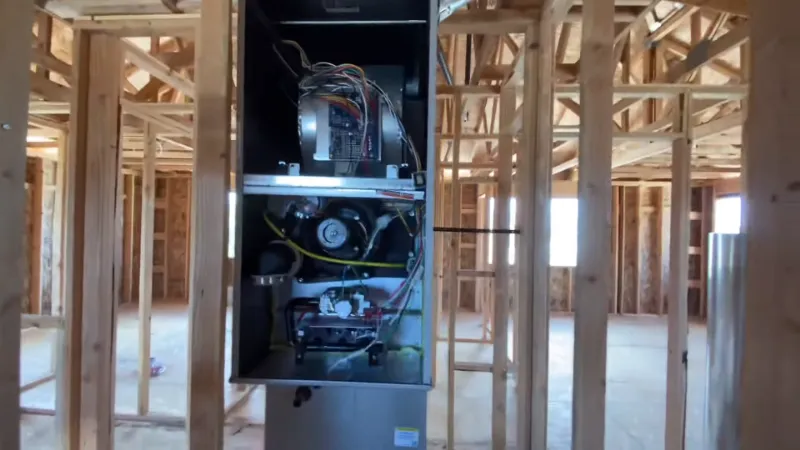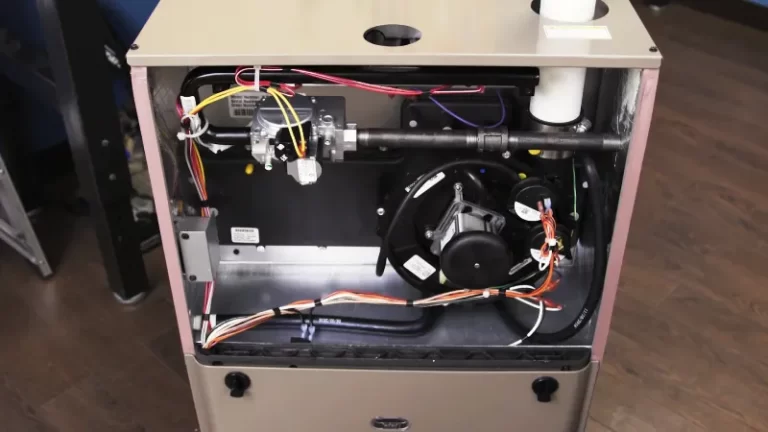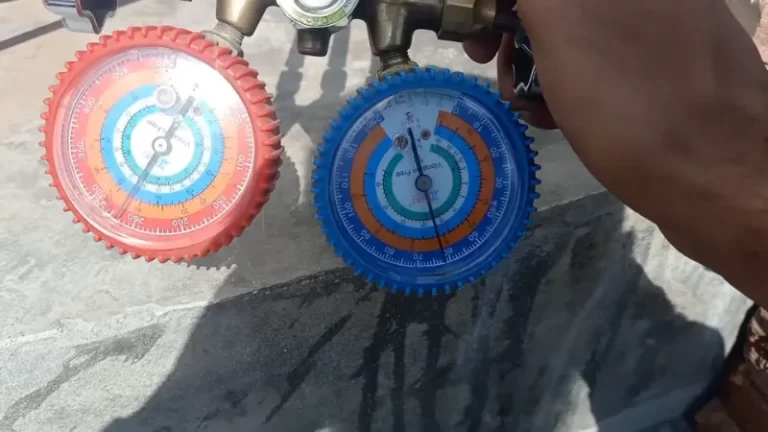Downflow Furnace With a Coil [Use Properly, Pros, Cons]

A downflow furnace is a type of heating system that uses a furnace to heat air, which is then distributed throughout the home or building through a system of ducts. The furnace itself is typically located in the basement or a utility room, and the air is distributed through the ducts to the various rooms.
A downflow furnace with a coil, also known as a packaged unit, is a variation of the traditional downflow furnace that combines both the heating and cooling coils in one compact unit. This type of furnace is often used in mobile homes and other small spaces where space is limited.
These units offer several benefits such as energy efficiency, space savings, and cost savings but also have some drawbacks such as limited repair options, and difficulty in accessing the coils for maintenance.
In this blog, we will be discussing the benefits and drawbacks of a downflow furnace with a coil and how to choose the right one for your home or building.
You'll Learn About
What is Downflow Furnace With a Coil?
A downflow furnace is a type of heating system that uses a furnace to heat air, which is then distributed throughout the home or building through a system of ducts. The furnace itself is typically located in the basement or a utility room, and the air is distributed through the ducts to the various rooms.
A downflow furnace with a coil, also known as a packaged unit, is a type of furnace that includes both the heating and cooling coils in one compact unit. This type of furnace is often used in mobile homes and other small spaces where space is limited.
These units are typically more energy-efficient than traditional split-systems, and they also tend to be less expensive to install. However, they can be more difficult to repair or replace if something goes wrong with the heating or cooling coils.
Advantages of a Downflow Furnace With a Coil
Energy Efficiency
A downflow furnace with a coil is more energy-efficient than traditional split-systems because it eliminates the need for separate heating and cooling units. This means that energy is not wasted on running multiple systems, and the unit is able to heat and cool your home more efficiently
Space Savings
Because the heating and cooling coils are located in one unit, it takes up less space than traditional split-systems. This is especially beneficial for mobile homes and other small spaces where square footage is at a premium. The compact design of these units also makes it easier to install, as it doesn’t require as much space as a traditional split-system
Cost Savings
The cost savings associated with a downflow furnace with a coil are twofold. Firstly, the unit is less expensive to install than traditional split-systems. Secondly, because the unit is more energy-efficient, it can help you save money on your utility bills in the long run
As a result, it can be a cost-effective option for heating and cooling your home.
Disadvantages of a Downflow Furnace With a Coil
Limited Repair Options
One of the main disadvantages of a downflow furnace with a coil is that the repair options are limited. When something goes wrong with the heating or cooling coils, it can be difficult to access the coils for maintenance.
The coils are located within the furnace, making it hard to reach them. This can make repairs more difficult and more expensive. In some cases, it may be necessary to replace the entire unit if the coils are damaged.
Difficulty in Accessing the Coils for Maintenance
Another disadvantage of a downflow furnace with a coil is that it can be difficult to access the coils for maintenance. Because the coils are located within the furnace, it can be hard to reach them.
This can make it difficult to properly maintain the unit and prolong its life. It may be necessary to hire a professional to perform regular maintenance on the unit, which can be an added cost. Additionally, the limited access to the coils can make it difficult to diagnose and fix problems if they arise.
Overall, while the downflow furnace with a coil has its advantages such as energy efficiency, space savings, and cost savings, it also has some drawbacks such as limited repair options, and difficulty in accessing the coils for maintenance that should be considered before making a purchase decision.
How to Choose the Right Downflow Furnace With a Coil
When choosing a downflow furnace with a coil, there are several factors to consider in order to ensure that you select the right unit for your home or building.
Size
One of the most important factors to consider when choosing a downflow furnace with a coil is the size of the unit. It is important to choose a unit that is appropriately sized for the space it will be heating and cooling. A unit that is too small will struggle to keep up with the heating and cooling demands of your home, while a unit that is too large will be less energy-efficient and may waste energy
Btu Rating
The BTU (British Thermal Unit) rating is a measure of the unit’s heating capacity. It is important to choose a unit with a sufficient BTU rating to meet the heating demands of your home or building. A higher BTU rating indicates that the unit is able to heat a larger area
Efficiency
Efficiency is another important consideration when choosing a downflow furnace with a coil. It is measured by the unit’s Annual Fuel Utilization Efficiency (AFUE) rating. A higher AFUE rating means that the unit is more energy-efficient and will help you save money on your utility bills in the long run
Proper Sizing and Installation
Choosing the right size and ensuring a proper installation is crucial for the efficiency and longevity of the unit. A unit that is too big or too small for the space it is heating and cooling will not work as efficiently and will have a shorter lifespan. A proper installation ensures that the unit is running at optimal efficiency and prolongs the life of the unit
Maintaining and Prolonging the Life of Your Unit
Regular maintenance is important to prolong the life of your unit. This includes cleaning and changing filters, checking for leaks and blockages, and having a professional inspect and service the unit on a regular basis. Proper maintenance will ensure that the unit is running efficiently and will help you avoid costly repairs down the road
While a downflow furnace with a coil offers several benefits such as energy efficiency, space savings, and cost savings, it is important to consider factors such as size, BTU rating, efficiency, proper sizing and installation, and maintenance when choosing the right unit for your home or building.
Comparison of Downflow Furnace with a Coil and Other Furnace Types
| Feature | Downflow Furnace with a Coil | Upflow Furnace |
|---|---|---|
| Airflow direction | Down | Up |
| Space requirements | Low | High |
| Energy efficiency | High | Moderate |
| Maintenance | Special consideration | Moderate |
| Cost | Moderate to High | Moderate |
Downflow Furnace with a Coil
This type of furnace pushes heated air down through the ductwork and into the living space, which is more efficient. They take up less space and have a more energy-efficient design than other types of furnaces.
Upflow Furnace
This type of furnace pushes heated air up through the ductwork and into the living space. They require more space than a downflow furnace and are less energy-efficient.
Overall, a downflow furnace with a coil is a great option for those who want to save space and increase energy efficiency, but it does require special consideration for maintenance. The cost is moderate to high and it’s recommended to consult with a professional for the best advice.
How to Use Downflow Furnace With a Coil Properly?
Consider the Type of Fuel
Downflow furnaces with a coil can be powered by gas, propane, or electricity. Each type of fuel has its own set of pros and cons, so it’s important to choose the one that best suits your needs and budget. Gas and propane-powered furnaces tend to be more efficient than electric models, but they also require a fuel source to be delivered to your home.
Check for Certifications
When purchasing a downflow furnace with a coil, make sure that it is certified by organizations such as Energy Star or the American National Standards Institute (ANSI). These certifications indicate that the unit has been tested and meets certain energy efficiency standards.
Check the Warranty
Make sure to read the warranty before making a purchase. A good warranty will cover both the cost of repairs and replacement parts, and will be valid for a certain period of time.
Have a Professional Check for Leaks
Before turning on your downflow furnace with a coil, it’s recommended to have a professional check for any leaks in the ductwork. Leaks can cause the furnace to work harder, which can lead to higher energy bills and reduce the lifespan of the unit.
Inspect the Air Filter Regularly
The air filter in a downflow furnace with a coil needs to be changed or cleaned regularly to maintain its efficiency. A clogged air filter can restrict airflow and cause the furnace to work harder, which can lead to higher energy bills and reduce the lifespan of the unit.
Frequently Asked Questions
What is the Difference Between a Downflow Furnace and an Upflow Furnace?
A downflow furnace is a type of furnace that pushes heated air down through the ductwork and into the living space. An upflow furnace, on the other hand, pushes heated air up through the ductwork and into the living space.
The main difference between the two is the direction in which the heated air flows.
How Do I Know if a Downflow Furnace With a Coil is the Right Choice for My Home or Building?
To determine if a downflow furnace with a coil is the right choice for your home or building, you should consider factors such as the size of the space that needs to be heated and cooled, the BTU rating of the unit, and the unit’s efficiency.
It’s also important to consider the cost of the unit and any potential maintenance or repair needs. It’s always recommended to consult with a professional to get the best advice.
Can a Downflow Furnace With a Coil Be Used in a Mobile Home?
Yes, a downflow furnace with a coil can be used in a mobile home. In fact, many mobile homes are equipped with downflow furnaces because they take up less space and are more energy-efficient than other types of furnaces.
However, it’s important to ensure that the unit you choose is appropriately sized for the space it will be heating and cooling, and that it is installed by a professional.
Are There Any Special Considerations for Maintaining a Downflow Furnace With a Coil?
Yes, there are a few special considerations for maintaining a downflow furnace with a coil. For example, it’s important to keep the coils clean to ensure that the unit is running efficiently. This can be done by cleaning the coils and checking for leaks or blockages.
It’s also important to have a professional inspect and service the unit on a regular basis to ensure that it is running optimally.
How Does a Downflow Furnace With a Coil Compare in Terms of Energy Efficiency to Other Types of Furnaces?
A downflow furnace with a coil can be very energy-efficient when compared to other types of furnaces. This is because the coils in the unit help to transfer heat more efficiently than other types of heat exchangers.
As a result, downflow furnaces with coils can have higher Annual Fuel Utilization Efficiency (AFUE) ratings, which means they are able to convert more of the fuel they use into heat energy. Additionally, the design of downflow furnace is such that it allow the air to circulate better through the ductwork and to the living space, resulting in more efficient heating.
Conclusion
A downflow furnace with a coil offers several benefits such as energy efficiency, space savings, and cost savings. However, it also has some drawbacks such as limited repair options and difficulty in accessing the coils for maintenance.
When selecting the right unit for your home or building, it is important to consider factors such as size, BTU rating, efficiency, proper sizing and installation, and maintenance. Proper installation and regular maintenance are crucial for the efficiency and longevity of the unit.
It is highly recommended that readers consult with a professional for proper installation and maintenance of their unit to ensure it runs efficiently and lasts for many years to come. With proper care and attention, a downflow furnace with a coil can be a reliable and cost-effective option for heating and cooling your home or building.


